Five pioneering low carbon housing projects secured for Building for 2050 research

Five pioneering low carbon housing projects have signed up to be part of the Building for 2050 research project, funded by the Department for Business, Energy and Industrial Strategy (BEIS). The project, launched today at the Futurebuild conference in London, will help shape future UK policy on delivering low carbon homes in England and Wales.
The project will review different ways of delivering low cost, low carbon homes and monitor their performance in use. The research team will work closely with the case study teams to understand the designs and any issues encountered and they will engage with residents to capture their views. This experience will inform ways to increase the widespread construction and uptake of low carbon homes in England and Wales by 2050.
The five housing developments comprise:
Active Homes in Neath, S Wales: a small development of 16 social rent homes by housing association Pobl Group. They are designed as mini power stations using battery technology, heat pumps and solar PV to generate around 80% of the energy they consume and slash tenants’ energy bills by at least 50%;
Rayne Park, Norwich is the largest low-energy ‘passivhaus’ development in the UK - and one of the largest in Europe, brought forward by Norwich Regeneration. The scheme will see 112 of the 172 new homes certified to the passivhaus standard. The homes will benefit from 70 per cent reduction in heating bills;
ETOPIA Homes, Corby is a scheme of 47 modular homes that are equipped with energy saving technology - a combined solar photovoltaic and thermal panel, heat pump, inter-seasonal storage and smart home equipment - to deliver a net zero carbon standard on site;
Marmalade Lane, Cambridge is a custom-built cohousing community. Made up of 42 custom build homes complemented by first-class shared facilities, Marmalade Lane has been designed with a fabric-first approach delivered with offsite manufactured closed timber panels supplied by Swedish builder Trivselhus, combined with heat pumps to supply heating and hot water;
Leyton Road comprises a mix of 50 new affordable and private flats and houses. The development, delivered under the London plan policy for low carbon homes, is the first to use a large-scale communal Air Source Heat Pump feeding an ambient temperature heat network and individual heat pumps, together with solar photovoltaic panels to provide a predicted 57% reduction in carbon emissions on site.
Building for 2050 is being managed by an AECOM-led research team, drawing on AECOM’s technical and social research expertise, and includes architects, Pollard Thomas Edwards; Building Performance Experts, Fourwalls and low carbon technology specialist, Delta-ee.
Alison Crompton, Regional Director, Sustainability – Building + Places, AECOM, said: “Signing up these five pioneering projects for our research is an important step towards future proofing new homes, paving the way for every new house in England and Wales to be low carbon and energy efficient. From early design right through to occupation, we’ll be combining technical and building performance reviews with social research to identify both the barriers and drivers of building low carbon new homes at scale.”
The team will capture the experiences of those directly involved with the five low carbon housing developments - reviewing the designs and observing construction activities; assessing the performance of sample dwellings; and determining the performance of selected dwellings in use over a year monitoring period.
There is a significant social research element and the team will identify the views of funders, developers, and design teams - those actively involved in low carbon housing and those currently not. Views from contractors and site-based staff building low carbon homes will also be collected. In addition, the attitudes and expectations of a sample of residents will be identified prior to them moving in to the five developments, followed by feedback once they have moved in and again once they have spent some months in their new homes. To provide context, views will be sought from wider stakeholders – both professionals and consumers. Observations from the design and construction stages, analysis of the performance at completion and over one year in use will inform the steps required to accelerate the uptake of low cost low carbon homes.






